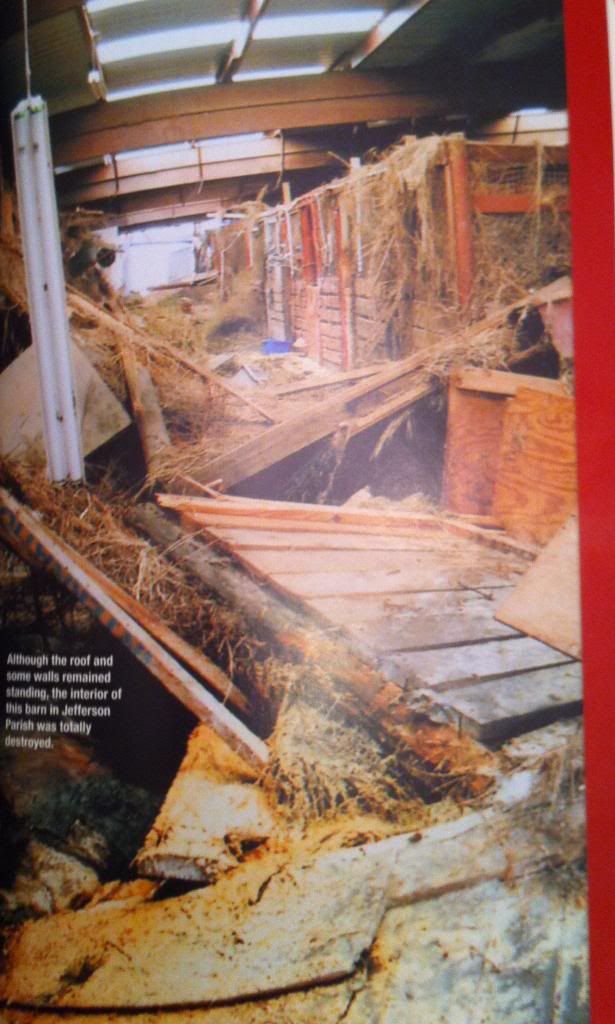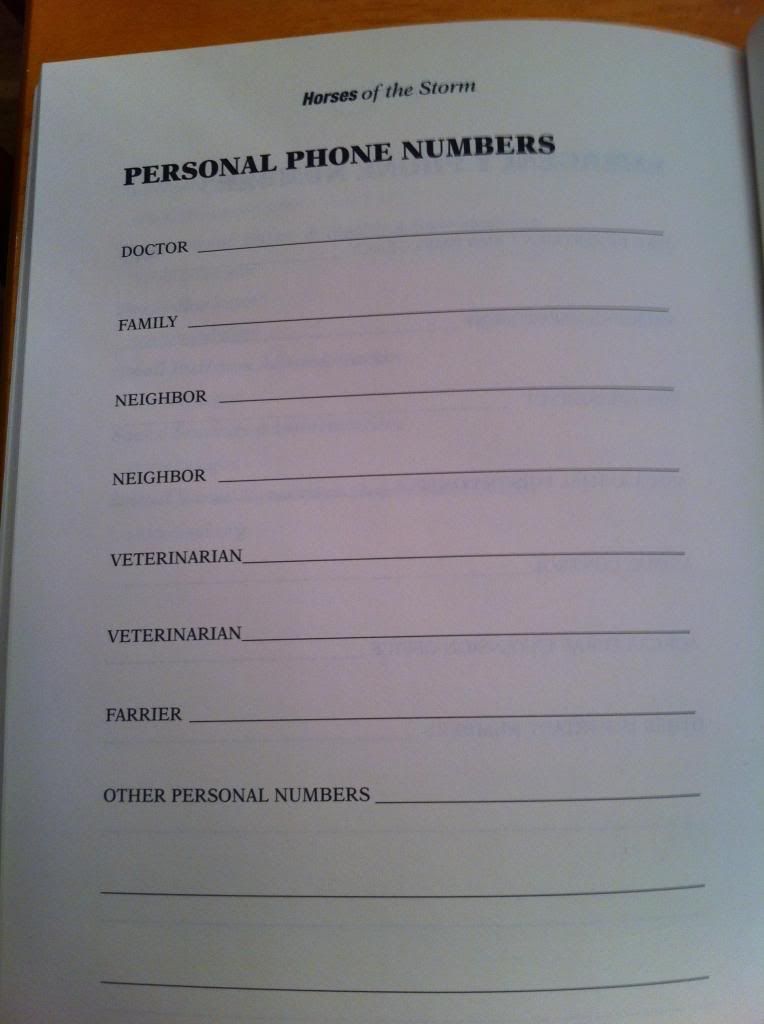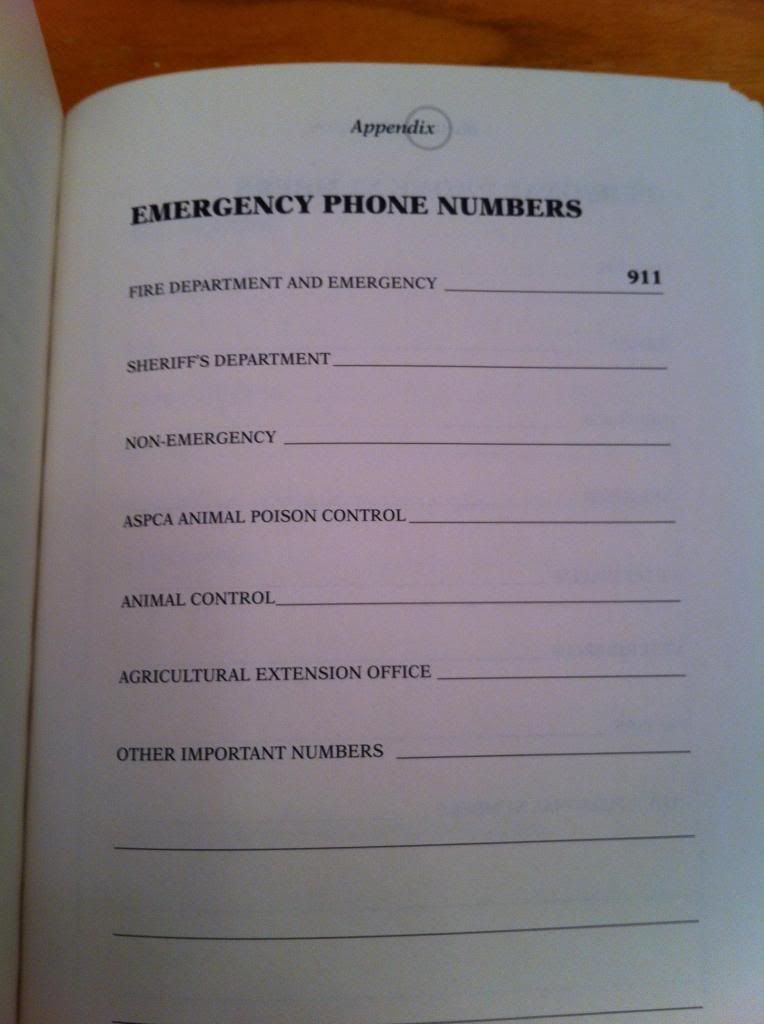I've learned, not just from my job but also from last years Waldo Canyon Fire, that you can never be too prepared. Being a large animal owner brings greater need for preparation than just being an individual in a home with a cat. You need to plan for your horse and you need to plan and react earlier to keep your animals safe. There are a variety of emergencies that can occur throughout the world, see below for just a few. The key is to determine what the threats are in your area and arm yourself with knowledge and resources.
Major Emergencies
Flood
Wildfire
Barn fire
Earthquake
Blizzard
Hurricanes
Emergencies of Shorter Duration
Power Outages
Well pump broken
Hail storm
Tornado
Hail storm
Tornado
The following book, Horses of the Storm by Ky Evan Mortensen was a great read. It discussed the planning and coordination for rescuing horses and other large animals after Katrina and then Rita. There were many lessons learned that Emergency Managers around the country have taken to heart and begun planning for their own communities. The main point I'd like to emphasive is that you are 100% responsible for your horses safety and well being, choices you make can effect whether your horse will or will not survive a disaster. Even with planning things can still happen so hopefully nothing bad will happen to any of the horse lovers reading this blog or horse lovers anywhere in the world for that matter!
After determining what emergencies occur in your area the next step is to determine whether you would normally evacuate or shelter in place. A blizzard for example is a good example of when to shelter in place. Make sure to get home to the horses before the storm hits so you don't have to worry about trying to get home to give them their regular care (if you board determine that someone will be there to care for the horses in this instance, many boarding barn owners live on site). For sheltering in place, aka staying where you are and hunkering down, make sure that you always have 3-7 days of supplies. Hay, grain, WATER!!! Don't count on electricity working and your well pump working; have a back up water source. 55 gallon clean trash cans can be filled and changed out regularly in your barn so that when the time comes you have fresh water....be creative! Also remember that horses drink around 10 gallons of water a day, give or take.
In some instances it makes sense to evacuate if you can; have that plan in place way before a disaster threatens. Have a trailer or plan to have a friend help you evacuate; discuss this with them! You also need to know where you are evacuating to. Smaller localized disasters are a little easier to plan for in that regard, if you know of other horse people outside of the effected area contact them in the planning stage to see if you could evacuate your horse to their facility. Locate boarding facilities that are a good distance away in order to evacuate your horse to their facility. If you discuss these options before a disaster is ever threatening you are ahead of the game.
For hurricanes, tornados, and floods if you cannot evacuate the horse releasing them into fields is the safest bet because they will likely escape the rising waters or run from danger when out in the open as apposed to a barn. The sad thing during Katrina is when people evacuated they left their horses in the barns with food and water for 3 days thinking this was the safest place for them. When Lake Pontchartrain's levees failed the flooding was immense and often these barns were filled to the roof with water. Horses in their stalls would swim and swim but eventually met their demise from exhaustion. Those out in fields more often were swept up with the currents and could swim to higher ground. There is a better chance for a horse to survive left to their own devices as tough as that decision may be for an owner. Granted an evacuation plan and evacuation is your best bet that your equine friend will be safe! Loose horses still presented challenges during the aftermath of Katrina!
 |
| Barn destroyed by the flood waters after Katrina |
Evacuate EARLY! Pre-evacuation notices should mean that you ACTUALLY evacuate your large animals and small animals since it takes longer and requires many more resources (truck, trailer, equipment etc). People often wait, and wait, and wait. Once there is a serious threat you should already have necessities packed and ready and when the danger appears imminent, meaning you feel extremely uncomfortable or you receive a pre-evacuation notice/voluntary evacuation don't hesitate; GET THEE GONE!! The sooner you leave the better, you won't have to deal with major traffic or be running around like crazy during a last minute trailer loading (never a good combination with horses!) Like I said before know a place you can evacuate to or discuss with your boarding barn the ability to evacuate all horses on the property.
Whether you are evacuating, sheltering in place or setting your horse loose in a field identification is very, very important. Place a break away halter on your horse with id tags, also braid an id tag into the mane or tail or both! Grease pens can be used to mark a horse with a phone number and there are also fetlock id bands that you can purchase. During Katrina live and deceased horses were all scanned for micro chips, this united so many horses with their owners (I'm sure the same goes for dogs!). Keep multiple copies of your vet and ownership records. Keep one in the barn, trailer and home and if you evacuate with or without your horse take these records so you can later identify your horse as yours to the authorities.
While planning before a disaster ever happens contact local offices of emergency management to find out if there is a County Animal Response Team (CART) in your area that could assist in evacuating horses, particularly if you don't have a trailer or a location to evacuate to. A lot of jurisdictions have locations to which they evacuate a lot of horses to during disasters and they can assist you in your planning. Most offices of emergency management are more than happy to assist you in planning, in fact they love it when people take the initiative!!
This post was just a quick snippet of what to think about when preparing your family and pets. Horses have a lot more issues that need to be considered during an evacuation because you can't just sneak them into a hotel like dogs or cats! Below are some links that have extensive information on preparing for emergencies, sheltering in place and evacuating with horses. I hope this post makes you think about what you would do in case of a disaster. Hopefully everyone will get their plans in place and never have to utilize them! Stay safe!
(NOTE: All pictures on this post were photographed from the above book, Horses of the Storm and are not property of this blog writer)





1 comment:
That is a great book! It is one of the 2 books that is going around in my "pass it on" give away. I do believe that Andrea, over at Mustang Saga has them now.
And you are right, being prepared is vital. After reading that book I realized that I have 4 horses and a 3 horse trailer, which means in the event of an emergency (fire or tornado here) I'd have to decide who to turn loose or leave behind. I cannot even imagine having to do that. We just made a deal on a 4 horse trailer and will be picking it up next week. Also I have started putting together my first aid box, and emergency preparedness kit.
Thanks for posting this.
Post a Comment